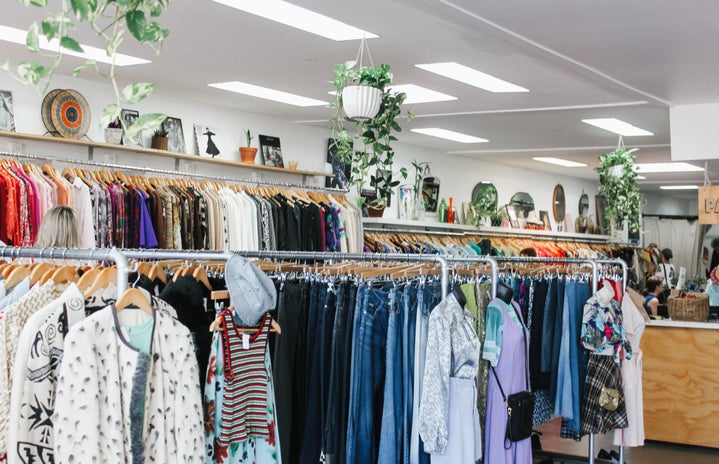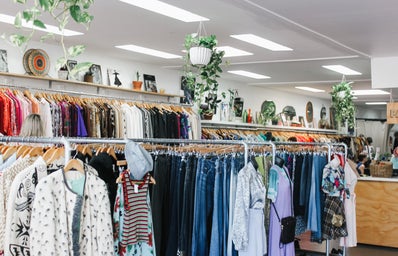The textile industry is one of the most unsustainable, unethical frameworks in modern society. It may be a little mind-boggling to think that the clothing you buy and wear is causing serious harm to the Earth, but it is. The way that we contribute and engage with the fashion industry adds to a larger social, political problem of an inhabitable planet. With clothing production being the third biggest manufacturing industry after the automotive and technological industries, production of textiles the world wears contributes more to climate change than international shipping and aviation combined. Not to mention that the average American throws away around 81 pounds of clothing yearly. It’s more than fair to say that the consumption of fashion at alarming rates, and the increasing waste, is the result of the rise of fast fashion.
Fast Fashion: The Facts
What is fast fashion? This is a buzz phrase you may have heard tossed around, but don’t know the meaning of. Fast fashion is a lot of things, but inherently it is “a design, manufacturing, and marketing method focused on rapidly producing high volumes of clothing.” It’s in the name: fast. Companies mass-produce the trendiest clothing items at the cheapest prices. This is meant to be eye-catching to consumers like you and me because the mass production of these garments leads to inexpensive price tags and constantly changing pieces in stores. Brands and companies get millions of dollars off the inexpensive clothing they push out and change frequently, and people eat up the prices and new trendy items, but there’s a lot of implications in this growing method among the industry.
We should be concerned as consumers about this rapid production for several reasons. Cheaper prices may seem like a “bargain” or “deal,” really, we have to consider that in the words of Lucy Siegle, an environmentalist writer, “Fast fashion isn’t free. Someone somewhere is paying for it.”
The urgency behind fast fashion is undoubtedly what keeps it alive. The 1960s was the first glimpse into what the phenomenon of fast fashion would be; the paper clothes campaign catalyzing the desire for faster production for in-demand styles. At the end of 1966, the garments topped $3.5 million for their popularity that was emphasized by icons at the time like Twiggy. Many decades later fast fashion had become ordinary for the way clothes were produced and companies earned big bucks. Before this time, trends in fashion ran according to the four seasons. Times have changed, now with estimations of there being 52 “micro-seasons” of fashion produced in a year. Let that sink in. The industry can barely keep up with itself; it’s over-producing faster than its audience of consumers can absorb new styles.
Environmental Impacts
The epidemic of fast fashion increasing in our culture, day by day, minute by minute, certainly has its effects on the consumers and companies in economic perspectives, but the environment is having its own share of detrimental effects. Fast fashion’s impact on our planet is almost too immense to even begin to describe. There are cheap, toxic textile dyes that pollute waterways and air. This has its negative impacts on animals, of course, with waterways being an entry for dyes and plastics that are residue of the production or waste of low-quality fast fashion clothing. Washing, solvents, and dyes used in manufacturing are responsible for one-fifth of industrial water pollution, and this production of fashion accounts for 20 to 30 percent of microplastic that flows into the ocean.
If you’re not familiar with the term, microplastics are tiny fragments of plastic that are shed from clothing that is made with synthetic materials. Synthetics can range anything from polyester, nylon, and acrylics. In 2015, a piece posted to Forbes detailed how, “nearly 70 million barrels of oil are used each year to make the world’s polyester fiber, which is now the most commonly used fiber in our clothing.” Here’s the real jaw-dropper: “it takes 200 years to decompose.”
These tiny, toxic fibers and dyes provide substantial harm to ecosystems. Aquatic environments, that are inhabited by birds, fish, and turtles, have seen significant damage with the rise of these microplastics infiltrating animals’ homes. Plastics from these clothing fibers can be so small, but just enough so that they can lodge in their throats, blocking digestive tracts and simultaneously throwing off eating behaviors, and diminishing the reproduction and growth rates in species or certain regions. The microplastics can have nasty, toxic chemicals that don’t add any good to the likelihood of microplastics making a home where they don’t belong. If you’re not so convinced by the way plastics shouldn’t be in the ocean or animal’s environments, then maybe you would be convinced knowing that some of those microplastics could end up in your dinner. Although studies by scientists show assurance that the microplastics within fish don’t move from the guts to muscle tissue, which is what you would eat of fish. However, it’s not a clear path ahead or idea we can turn our heads from, because scientists don’t have the analytical tools to measure the health impacts if fast fashion production continues at this rate, streaming billions more microplastics into waterways. So, ultimately, those plastics could end up on your plate.
This ties into the real big issue of the environmental implications with fast fashion.
Can’t see the issue? Easiest just to ignore it, right? Wrong!
The rapid production of fast fashion relies on consumers wanting to stay “in style” and get a bunch of low-quality, cheap pieces that they will throw out in the next week or month. Only to pick up their credit card and get a whole new wardrobe full of harmful, cheap, and “trendy,” clothing. It’s a whole culture in itself, and it only gets more shocking and bizarre by the day. People’s ignorance and negligence surrounding it adds to the massive problem we have at hand: the cost of fast fashion is severely detrimental to our lives and this planet.
So, what now?
Obviously, fast fashion isn’t pleasant. I tried my best to consolidate the relevant facts and statistics, but one Google search is bound to make you wallow in guilt for hours on end. You’re already a step ahead in making change if you’re pissed about this. Acknowledging the way that fashion production can impact the environment and other people’s lives is an understated, but important step.
It’s really upsetting to consider how we have contributed to this growing, greedy system. It’s like a parasite that’s been living inside us for so long, and now we are forced to itch at it, hoping its presence will move along. It’s not all on you as the consumer though, let’s be clear. You can make individual changes in your personal lifestyle and consumption of fashion, but you can align those choices with the extent to which you are considerate of the still greedy inner workings of seemingly “better, more sustainable” options. Understand and highlight your privilege in being able to boycott fast fashion almost instantly. Some things are more or less accessible or attainable for certain people. This sustainability movement and options still need work; there are a lot more complexities to this.
There are so many good videos on social media platforms where creators educate their audiences on issues of sustainability and fast fashion. Before diving into these basic outline of tips, I wanted to highlight the words from a video essay by Sincerely Tahiry titled, Fast Fashion is a Rich People Problem, where she says, “We’re [BIPOC] trying to dismantle whole systems that we all engage in every single day, and for white people, they look at it from the outside perspective and they think it’s just as simple as fast fashion, but they don’t look at the complexity surrounding these things. They don’t look at financial privilege, the racial privilege, size privilege, and etc.”
Definitely an important concept to let simmer on your mind. Sustainability is not a linear or concrete idea, because we haven’t unfortunately reached the point where everyone has the same accessibility to more ethical, transparent brands. However, some considerations may have the potential to not only lessen people’s reliance on fast fashion but revitalize a universal love for personal style.
Be a Conscious Consumer
I guess it’s silly to suggest that one of the most important things you can do right now, with the way the sustainability movement is moving, for being more sustainable is to be thoughtful. What does thought have to do with this? How does that create any substantial change?
Think about the next time you browse your favorite online website or walk into a store, and you’re endlessly assessing your options of what to buy. It’s a simple thing, but if you challenge yourself about the necessity of a purchase then you’ll definitely lessen your need for fast fashion.
Ask yourself these questions:
Will I wear it a minimum of 30 times?
Does this align with my personal style or am I only considering it because it’s trendy?
Do I have clothes in my closet already that I can style this with?
Take it a step further:
Who made this?
Is this price fair?
What fabrics are used?
Is this a transparent brand?
The question that’s layered in all of these, and requires the most discipline: Do I really need this?
Go Thrifting & Upcycle
One of the best combative measures to fast fashion right now that you can partake in is thrifting. If you’re not familiar with what thrifting is, essentially it’s a form of shopping in stores that have discounted prices and sell gently used items. This could be in the setting of an actual store, garage sale, or flea market. A lot of places that sell secondhand items also contribute the sales to a charity or cause. This is a fantastic way to not only buy something that has the potential for a long, second or third life in your wardrobe, but to put your money in a good place. It’s local, and it’s giving something to your community.
Although you can go in person to stores that are local, there are definitely affordable options online.
ThredUp: https://www.thredup.com/
Poshmark: https://poshmark.com/
Depop: https://www.depop.com/
Vinted: https://www.vinted.com/
Etsy: https://www.etsy.com/
There are a plethora of options, and it really depends on what you’re looking for! Even when thrifting, make sure to be still conscious of the prices and your intended use for the clothing.
Upcycling is another way that you can make conscious thrift shopping fun and refreshed. We all learned “reduce, reuse, recycle,” when we were kids, so let’s utilize the reuse option and add revamp to that too! If you’re handy with some scissors, a sewing machine, or other alternatives, you can easily cinch a skirt’s waist, or turn something into, say, a halter top. There’s a lot of tutorials out there on clothing that you can upcycle, and how to do it properly and safely. This definitely goes hand in hand with thrifting; you can really build your dream wardrobe sustainably and personally all in one!
In Conclusion
The issue of fast fashion is a hefty, complex issue. There is no foolproof way to get around right now; the best thing we can do is reduce the amount of it that we consume. But, we can’t guilt ourselves too much if we aren’t perfect. It’s the effort that counts. Intention not perfection.
Some brands are becoming more sustainable and transparent in their efforts to be so, but there’s a long road. Greenwashing is on the rise, and there is still a lot of weeds to cut through. It’s hard to say what the outlook will be for the industry in five or ten years because the effect on our planet will be much more apparent. I do think personally people’s awareness of fast fashion’s harm is growing every day, and that can only be encouraging for the way that fast fashion will change in our lifetimes.
Let’s keep the conversation rolling and remember that every day is a good day to care about your interaction with and consumption of fashion!



